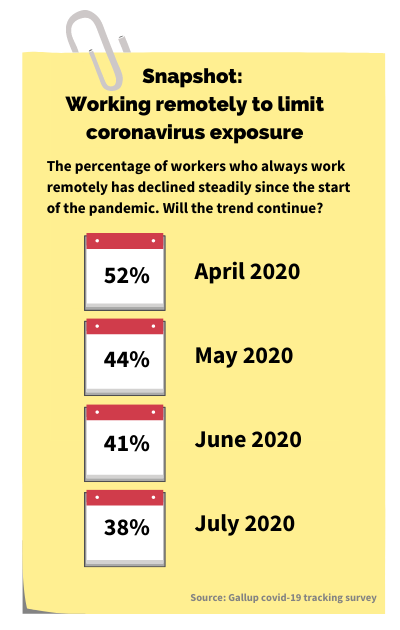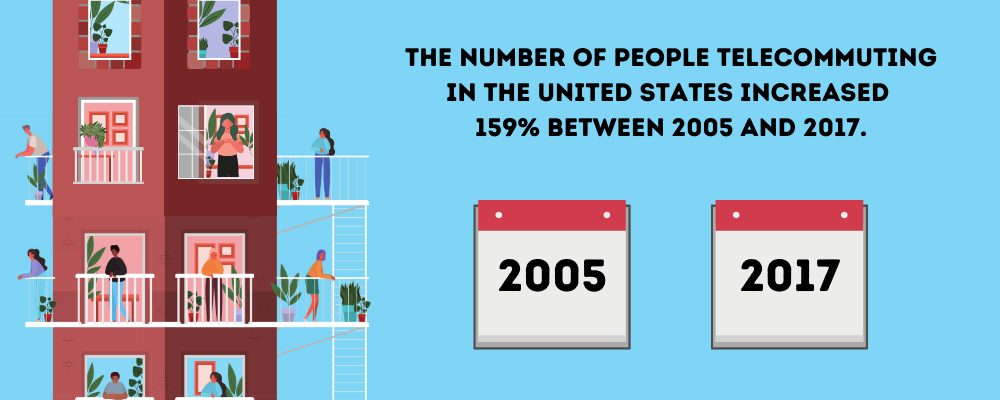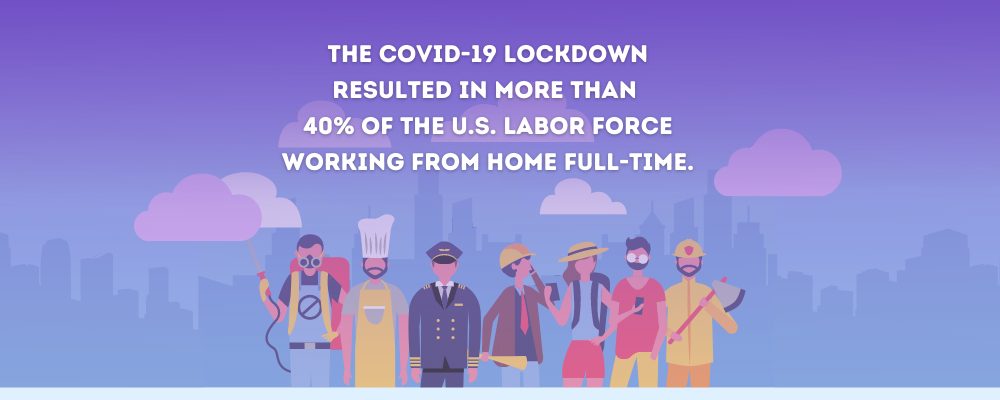Is working from home going to be a permanent thing?
 Remote work as a viable option has grown steadily throughout the 21st-century. Supported by technological advances and the desire to better integrate professional and personal obligations, the number of people telecommuting in the United States increased 159% between 2005 and 2017. Nobody, however, could have predicted the explosion to come.
Remote work as a viable option has grown steadily throughout the 21st-century. Supported by technological advances and the desire to better integrate professional and personal obligations, the number of people telecommuting in the United States increased 159% between 2005 and 2017. Nobody, however, could have predicted the explosion to come.
The COVID-19 lockdown resulted in more than 40 percent of the U.S. labor force working from home full-time. Without such a shift, experts say the economy would have collapsed or infection rates would have been much worse because people would have returned to the office well before safely feasible.
Remote work indeed proved a godsend for many during a tough time. Kate Lister, president of Global Workplace Analytics, estimates that “work-at-home saved U.S. employers over $30 billion a day in what would have otherwise been lost productivity during office closures due to COVID-19.”
But most companies viewed the new arrangement as a temporary solution. Permanent remote work was not in their plans – until they began noticing that perhaps it wouldn’t be such a bad idea.
The benefits of remote work
The rapid, large-scale transition to remote work threw both employers and employees for a loop at the start. Companies scrambled to ensure people had what they needed to perform their jobs and could communicate effectively with one another. Management quickly developed productivity standards to measure performance and give workers a framework in an unfamiliar environment.
Slowly but surely, Zoom meetings ceased to be a novelty and Slack channel chat started to feel reminiscent of the office water cooler. As the dust settled and the “forced experiment” continued, leaders saw things they had not predicted.
“Over the past few months, we realized that the company still ran as usual, sometimes better, even with a remote workforce,” says Jay Scott, proprietor at Pugsquest, a company focused on pugs and their care. “Our employees significantly enjoy the flexible working hours, the less pressure, and being able to have more time for their families and social life. Productivity and work performance have also improved for the most part with most employees giving work their best. We have also been able to acquire a great pool of talent that we would have otherwise overlooked if we remained on work-in-office mode. Finally, we have cut back on expenses such as the costs of office space and working equipment, which has allowed us to invest on more important parts of the company.”
Daniel Carter, founder of Zippy Electrics, expresses similar sentiments.
“Most of my employees enjoy working from home because they have more time to spend with their family. Admittedly, I feel the same,” Carter says. “It’s also cost-effective as I no longer need to rent office spaces nor do my employees have to shell out gas money or public transportation fare. The time that we use to go to and from work is spent doing better, more meaningful things at home such as having fun with your family or immersing yourself in a creative project. For me and my employees, working from home allows us to save the most valuable resource there is and that is time.”

Research supports what these leaders are saying. According to Global Workplace Analytics:
- A typical employer can save an average of $11,000 per half-time remote worker each year (derived from a combination of increased productivity; reduced turnover, absenteeism, and real estate costs; and being able to continue working in the event employees cannot get to work).
- A typical employee can save between $2,500-$4k/year (net of the additional costs incurred by working from home).
- 86 percent of North American workers say they feel fully productive at home. They gain back 35 minutes each workday due to fewer unwanted interruptions (43 minutes/day at home vs 78 minutes/day in the office).
- 70 percent of managers say they are just as satisfied with work performance or have seen better results since instituting remote work.
- 77 percent of employees are satisfied with the flexibility they have working at home, and 69 percent are satisfied with their well-being.
Not everyone is sold on permanent remote work
Despite many employers’ newfound enthusiasm for remote work, others express a longing to get all staff back to the office – especially in order to improve collaboration.
“COVID has opened my eyes to the disadvantages of a work-from-home environment,” says John Ross, founder and CEO of the test prep review company Zivadream. “Not only have we encountered the technical issues that almost all firms face, but I have also noticed a dramatic decline in innovation and process improvement. Being an agile startup, we are always looking for new ideas and efficiency gains. I’ve noticed that since our employees no longer interact in person, and communication is limited to clunky Zoom calls, email and Slack, those improvement ideas have come to a halt. As a result, my long-term plan following COVID is to revert back to a traditional ‘butts in seats’ approach.”
Similarly, not all employees desire permanent remote work. In Pulse of Remote Work: Before & After COVID-19 — a survey conducted by the work management platform Pipefy — 41 percent of new remote workers (those who became telecommuters because of the lockdown) said they would like to return to the office full-time following the pandemic. Some of the biggest challenges they report facing at home include distractions (63 percent), work-life balance (36 percent), collaboration and communication issues (31 percent), and no designated office space (28 percent).

Exploring hybrid work options
The aforementioned survey also revealed that 39 percent of new remote workers would like to work from home part-time after COVID-19. This potential “best of both worlds” scenario draws interest from many employers, too.
“When it comes to working from home as a permanent arrangement, I am considering giving my employees the option to do so if they so choose to. I don’t intend on getting rid of offices altogether as I value in-person collaboration and the cultural benefits that having an office provides,” says Jason Akatiff, co-founder of Boundery, a company devoted to innovative lifestyle products. “I am looking into downsizing our office space and offering employees the option of having space if they need it but also staying flexible if they choose to continue to work from home. My business hasn’t suffered from closing our offices, and my employees have repeatedly shown higher productivity levels and overall happiness while working remotely. I would be foolish not to take this into account when implementing changes to our work environment in the future.”
What comes next?
Plenty of factors will come into play as businesses make decisions going forward. Obviously, some jobs lend themselves more easily to working from home than others. Likewise, COVID-related issues such as a vaccine (or lack of one), local regulations concerning occupancy, and possible virus resurgence will continue to affect actions. Expect the knowledge about remote work gained over the past few months, however, also to come into play as leaders forge ahead during uncertain times.







